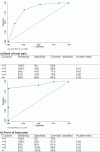Pilot development of diagnostic tools for lower limb apophyseal injuries in children and adolescents
- PMID: 39314841
- PMCID: PMC11418814
- DOI: 10.7717/peerj.18101
Pilot development of diagnostic tools for lower limb apophyseal injuries in children and adolescents
Abstract
Introduction: Lower limb apophyseal injuries commonly occur in children and adolescents with unknown incidence and prevalence. These conditions are considered benign, but impact children and adolescents quality of life and can lead to sport withdrawal at a crucial time. The primary aim of this research was to develop self-administered tools for two of the most common apophyseal injuries. The secondary aim was to test the sensitivity and specificity of the tools.
Methods: Study 1 used a three round online Delphi panel (n = 8), with expert consensus supported by robust literature. This panel developed a self-administered screening tool for calcaneal (Sever's disease) and tibial tuberosity (Osgood-Schlatter's disease) apophysitis. Study 2 tested the sensitivity and specificity of these developed tools with parents and children (n = 63) with concurrent clinical examination by a health professional. An initial sample size for Study 2 was set at 155 children however this was impacted by COVID-19 and recruitment was halted.
Results: Both tools had excellent diagnostic accuracy with an area under the curve of 83% (95% confidence interval = 0.70 to 0.95) for the posterior heel (calcaneal apophysitis) tool and 93% (95% confidence interval = 0.80 to 1.00) for the anterior of knee (tibial tuberosity apophysitis) tool using the pilot data from the 63 children.
Conclusions: These tools may also enhance opportunities for clinicians and health service providers with pre-clinical screening to reduce wait list time and encourage low cost, self-administered management where indicated. These findings may enable large epidemiological studies to identify populations and calculate incidence and prevalence of these conditions using self report.
Keywords: Apophysitis; Children; Delphi technique; Foot; Knee; Telehealth.
© 2024 Brooks et al.
Conflict of interest statement
The authors declare that they have no competing interests.
Figures
Similar articles
-
Incidence of calcaneal apophysitis (Sever's disease) and return-to-play in adolescent athletes of a German youth soccer academy: a retrospective study of 10 years.J Orthop Surg Res. 2022 Feb 9;17(1):83. doi: 10.1186/s13018-022-02979-9. J Orthop Surg Res. 2022. PMID: 35139872 Free PMC article.
-
Incidence of calcaneal apophysitis in Northwest Istanbul.BMC Musculoskelet Disord. 2018 Jul 27;19(1):267. doi: 10.1186/s12891-018-2184-6. BMC Musculoskelet Disord. 2018. PMID: 30053810 Free PMC article.
-
Ultrasonography of the calcaneus in Sever's disease.Indian Pediatr. 2005 Aug;42(8):801-3. Indian Pediatr. 2005. PMID: 16141482
-
Apophyseal injuries in the young athlete.Am Fam Physician. 1995 Jun;51(8):1891-5, 1897-8. Am Fam Physician. 1995. PMID: 7762480 Review.
-
Describing Frequencies of Lower-Limb Apophyseal Injuries in Children and Adolescents: A Systematic Review.Clin J Sport Med. 2022 Jul 1;32(4):433-439. doi: 10.1097/JSM.0000000000000925. Epub 2021 Apr 7. Clin J Sport Med. 2022. PMID: 34009802
References
-
- Adler M, Ziglio E. Gazing into the oracle: the delphi method and its application to social policy and public health. Bristol: Jessical Kingsley Publishers; 1995.
-
- Chen W, Thrower M, Garrood T. P91 Bringing patients into the referral process: an evaluation of pre-appointment questionnaires in a rheumatology new patient pathway. Rheumatology. 2020;59:keaa111. doi: 10.1093/rheumatology/keaa111.089. - DOI
MeSH terms
LinkOut - more resources
Full Text Sources
Medical




